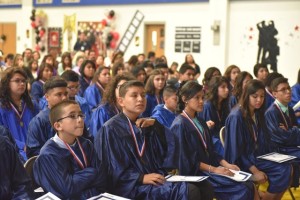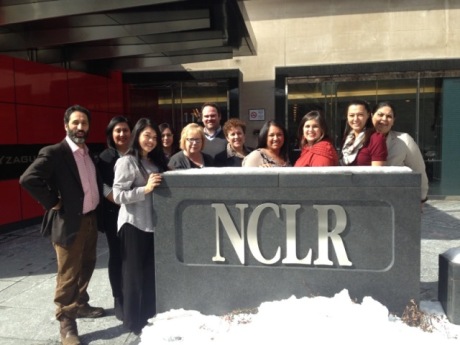ESSA Implications for Latinos and English Learners April 26, 2016
Posted by latinoschoolleaders in Education Policy.Tags: EL, ELL, English learners, ESSA, Every Student Succeeds Act
add a comment
By Dr. Christopher R. McBride, Mariposa Academy of Language and Learning
Latino students represent one of four students in classrooms across the United States and are projected to represent about one in three students by 2030. There are nearly five million English learner (EL) students and 80 percent of them are Spanish speakers. Furthermore, in 2013 only about 61 percent of EL students graduated high school compared to an average of about 75 percent of Hispanic students and over 86 percent of White students. Clearly our Latino and EL populations are growing and we, as a nation, are not meeting their educational needs. If we do not do a better job educating these students to prepare them to succeed in college and life afterward, we will all suffer.
Aware of the facts around Latino and EL students, the question weighing on the minds of many educational leaders is, “How will the new Every Student Succeeds Act (ESSA) impact our ability to close the achievement gap for Latinos and English learners?” The answer to this question is that it depends on the specific implementation in your state. ESSA has provided for increased funding for ELs by increasing Title III authorization levels. ESSA also leaves greater discretion to states to develop suitable accountability systems for when they are failing groups of students and has moved accountability for ELs from Title III to Title I. Therefore, it is critical to the success of Latinos and ELs students that states adopt provisions to better track and improve the educational performance of ELs.
Fortunately, ESSA requires that all schools must demonstrate that they are improving the English proficiency of ELs as English language proficiency is now a required indicator in every state’s school accountability system. This should encourage states to increase resources for ELs. Additionally, Title III will now require states to disaggregate ELs with a disability from the EL subgroup as well as report the number of ELs who have not attained English proficiency within five years of identification as an English learner.
So what can educational leaders do to help ensure that ESSA leads to the greatest possible achievement outcomes for Latino and EL students? Be at the table when your state is designing the accountability system to give your input on what are appropriate goals and indicators to help put every student on the path to college- and career-readiness. The accountability measures must include assessment performance, high school graduation rate, one or more additional academic indicators for elementary and middle school, language proficiency progress, and at least one other indicator of school quality or student success. What should the goals be? What should all of the indicators be and how much weight should they have? These are big questions. The answers and implementation in your state will have profound impacts on Latino and EL students.
I wish that I had the answers to all of these questions. The truth is, I don’t. What I do know, however, is that when local school leaders have input into answering these questions and designing the implementation, there is a much greater likelihood that Latino and EL students will graduate from high school college- and career-ready. As a school leader in Nevada, with a student population over 40% Latino and around 75,000 ELs, this is critical to the long-term well-being of our state.
Dr. Christopher R. McBride is the Director of Mariposa Academy of Language and Learning, a pre-K–5 charter school that has the mission to put every student on the pathway to graduate high school with a seal of biliteracy, prepared for college, and life success, in Reno, Nevada.
A Unique Model: A Charter School for Adult Immigrant Education September 24, 2015
Posted by latinoschoolleaders in Uncategorized.Tags: Carlos Rosario International Public Charter School, Ryan Monroe, School Reform Act
add a comment
By Ryan Monroe, Chief Academic Officer, Carlos Rosario International Public Charter School
We love our amazing and unique school. It’s the kind of place where on a cool spring morning you might see a Nigerian woman in traditional garb dancing to a Mariachi band with the Prince of Wales.
Carlos Rosario International Public Charter School is unique in other ways, too. It’s the nation’s first charter school for adults and has served over 60,000 adult immigrants in its nearly 45 years of service, 18 of which has been as an adult education charter. We currently have 2,200 students on two campuses. Learners come from 80 different countries and speak 30 different languages. 70% come from Latin America. They learn English, gain basic literacy skills, receive job training, earn GEDs, and become United States citizens. Our students access support services to get help to remove whatever obstacles stand in the way of their dreams.
When it converted to a charter school in 1998, after Congress passed the School Reform Act in 1996, the Carlos Rosario School became the first adult education charter in the nation. Since then, eight other adult charter schools have been approved by the Public Charter School Board of the District of Columbia, and funded through local monies by the DC City Council. This vote of confidence in adult charters is a development that should make other localities sit up and take notice.
Why invest in adult basic education through the charter movement?
- The Survey of Adult Skills known as PIAAC notes the association of low literacy with poor health as well as other negative social and employment outcomes. The report recommends taking action to improve the skills of low-literacy individuals, particularly Black and Hispanic adults.
- Researchers funded by the National Institutes of Health concluded that programs to boost the academic achievement of children from low-income neighborhoods might be more successful if they also provided adult literacy education to parents. The researchers based this conclusion on their finding that a mother’s reading skill is the greatest determinant of her children’s future academic success.
- The Brookings Institute highlights the Carlos Rosario School as an innovative model for adult education and recommends consideration of charter schools as a way to fund adult education, stating, “The relative stability of charter funding allows adult education providers to build their programmatic and staff capacity to serve more students with high quality offerings in a way that is difficult to achieve with more uncertain or fluctuating revenue sources, such as grants and contracts.”
Charter schools earn autonomy in exchange for high levels of accountability. At the Carlos Rosario School we strive for excellence, and by learning and growing throughout our 18 charter years we have been able to achieve our targets. We are proud to have been found exemplary in every area: governance, finance, operation, climate, and academics. Our students achieve rigorous academic targets in English, GED, career training, job gains, persistence, and other measures at a level that earns us a Tier 1 ranking.
Beyond the numbers, we are a multilingual, international community of learners with a welcoming and inclusive climate where our students know that they will achieve their American Dream. Watch our short video to see some of our learners’ successes.
Last year Prince Charles stopped by and got to experience our amazing community. As our new school year begins, Carlos Rosario staff and faculty are anticipating more visitors—probably not royalty this year, but educators from around the country who are considering adult charters for their own districts.
At AAMA Sanchez Charter School, Our Teachers Understand Their Students’ Struggles August 14, 2015
Posted by latinoschoolleaders in Cultural Relevance, Principal Effectiveness.Tags: AAMA Sanchez Charter School
add a comment
By Bianca Arriazo, National Latino Institute for School Leaders Fellow, NCLR
A 19-year-old high school senior walks into an office: “I just got kicked out of class again, Miss.”
“What happened now?” asks the person behind the desk.
He responds, “I was just resting my eyes.”
In moments like this educators realize they are the keepers of a student’s academic life. They understand there is a reason for this student being sleepy and they have to share his story with fellow educators. As a team, they have to develop a plan to keep him awake and engaged in his classes so he can make it to Graduation Day.
From an outsider’s view, the question lingers as to why this student is still in school and why he’s received multiple opportunities after acting out and being disrespectful. However, there’s more to this young Latino boy who wears baggy pants, has tattoos in the most random places, hates wearing his school uniform, and has poor attendance. He is being raised by a single mother who works all night at a warehouse. She is only able to tell him he needs to go to school but not able to give him a good reason. He tries to help by working odd jobs but he is influenced by his classmates, buddies, and surroundings and ends up spending his money and time frivolously. Soon after he becomes a father and faced with the urgency to mature and become responsible for another person. He gets a steady job but works long hours, sometimes until 2:00 or 3:00 in the morning. He knows he needs to graduate yet he has to overcome so many obstacles, just like countless other students in the public school system.
At AAMA Sanchez Charter School, our school population is 98 percent Latino, 48 percent of whom are English language learners. We are an open enrollment charter school and often serve as a second-chance school for students. Our teachers and staff make it a priority to establish relationships with our kids so when a student joins us, they know they are now part of our familia. Most of the time our staff becomes the rock in our students’ lives. Our teachers are not able to be traditional. They have to incorporate art, technology, and a student’s personal interests into every lesson so kids can stay engaged and awake in their classrooms. Our campus has to be mi casa for every student.
Our Principal, John De La Cruz, frequently reminds us “parents are sending us their very best.” With that in mind, we are at the beginning of another year and we will invest all our efforts and emotions on preparing for the many English language learner newcomers, as well as all the other Latino youth who will walk through our door on the first day. We know they will come to us with many needs and gaps in all areas, especially in English language acquisition. We also know they will have to face many social challenges, becoming teenage parents, battling drug addictions, reporting to their parole officers, and just making mistakes and maturing in general. Nevertheless, we also know it will be our mijos and mijas who become our future leaders and parents.
In the end, we may not exceed expectations in all testing areas, but we sure help create and close a chapter in each one of our student’s lives.
A School Year in Review: Camino Nuevo Charter Academy June 24, 2015
Posted by latinoschoolleaders in Common Standards, Principal Effectiveness, School Year in Review.Tags: California Common Core State Standards, Camino Nuevo, Camino Nuevo Charter Academy, CCSS, co-location, Common Core, Common Core State State Standards, LAUSD, LCAP, Local Control Accountability Plan, Local Control Funding Formula, Los Angeles Unified School District, Prop 39
add a comment
By Heather McManus, Principal, Camino Nuevo Charter Academy
As another school year winds down, educators throughout California will reflect on the last 10 months of student progress, overall growth toward goals, and how we have changed as individuals and professionals. This year’s evolution was memorable for us at Camino Nuevo Charter Academy (CNCA) as well as at many other schools across California.
This school year brought with it many celebrations and challenges. Wrapping up a $36 million construction project that was delayed for nearly a year, we packed up 15 years’ worth of school memories and moved into Belmont High School to experience a co-location. Co-location, also known as “Prop 39,” pairs up public charter schools with local public district schools that are under-enrolled to share the space and school facilities.
Co-location can be challenging for all parties involved. Due to the expensive nature of land and real estate in California, Prop 39 remains an important option for many public charter schools in underserved neighborhoods. This year, the California Supreme Court impacted the law’s implementation in some school districts. In April, the Court ruled that the Los Angeles Unified School District (LAUSD) had been violating Prop 39 and required LAUSD to make changes to ensure that its methods of allocating classrooms to all schools are lawful.
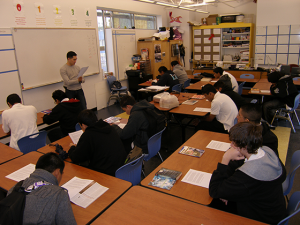 The past year also brought an influx of revenue directed toward public schools and a new state funding mechanism: the Local Control Funding Formula (LCFF). Under this revolutionary model, schools receive a base amount of money, and those that serve a majority of students who live in poverty, are English language learners, or are foster youth receive a concentration and supplemental grant above the base amount. Historically, schools in the most needy areas operate on fewer dollars than schools in more affluent areas because they are funded by community tax dollars.
The past year also brought an influx of revenue directed toward public schools and a new state funding mechanism: the Local Control Funding Formula (LCFF). Under this revolutionary model, schools receive a base amount of money, and those that serve a majority of students who live in poverty, are English language learners, or are foster youth receive a concentration and supplemental grant above the base amount. Historically, schools in the most needy areas operate on fewer dollars than schools in more affluent areas because they are funded by community tax dollars.
With the implementation of LCFF, schools are held accountable by creating a Local Control Accountability Plan (LCAP). At Camino Nuevo Charter Academy, parents, staff, and students participated in budget meetings, surveys, and presentations related to the eight state priorities and CNCA-specific priorities. Our plan prioritized, among other things, providing mental health services, interventions for struggling students, and a well-rounded education. As the year winds down, schools are measuring progress toward the goals outlined in the accountability plan and writing updated versions of their plan for next year.
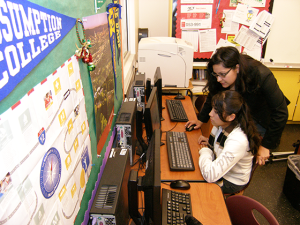 Finally, this school year saw the first full-year implementation of the new California Common Core State Standards. These standards require schools to dramatically shift classroom instruction. This spring, students throughout the state engaged in the first round of the Smarter Balanced Assessments. At CNCA, students in grades 3–8 took four assessments over eight days and a total of 16 hours. They had to successfully navigate the new technology testing platform as well as more rigorous standards. While California will not use this year’s results in calculating the state’s accountability tool, the Academic Performance Index, at CNCA we are anxiously awaiting our scores to help us push our work forward.
Finally, this school year saw the first full-year implementation of the new California Common Core State Standards. These standards require schools to dramatically shift classroom instruction. This spring, students throughout the state engaged in the first round of the Smarter Balanced Assessments. At CNCA, students in grades 3–8 took four assessments over eight days and a total of 16 hours. They had to successfully navigate the new technology testing platform as well as more rigorous standards. While California will not use this year’s results in calculating the state’s accountability tool, the Academic Performance Index, at CNCA we are anxiously awaiting our scores to help us push our work forward.
In these final few days of the school year, we’re working to close it out while moving swiftly toward the next. We are already planning and hiring for 2015–2016 and look forward to continuing to provide students with an excellent education.
Here’s to a great school year and a restful summer!
Celebrating College Admissions May 28, 2015
Posted by latinoschoolleaders in College Readiness.Tags: ACT, Alyssa Rizo, College Admissions, Grand Canyon University, SAT
add a comment
By Crystal Gallegos, High School Principal at Chavez/Huerta K-12 Preparatory Academy
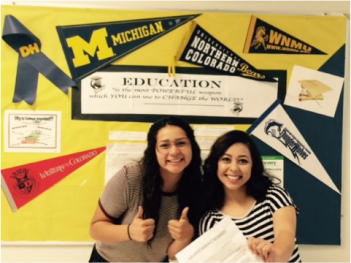 When you think about high school and the significant events that take place over those four years, it brings up a rollercoaster of emotions that students, parents, and school faculty go through. As an early college preparatory high school in Pueblo, Colo. our focus at Chavez/Huerta is to push students to succeed and be college- and career-ready. So much in fact, that beginning in kindergarten and going through senior year of high school, every grade level visits a college campus and is exposed to two-year and four-year public and private institutions of higher learning.
When you think about high school and the significant events that take place over those four years, it brings up a rollercoaster of emotions that students, parents, and school faculty go through. As an early college preparatory high school in Pueblo, Colo. our focus at Chavez/Huerta is to push students to succeed and be college- and career-ready. So much in fact, that beginning in kindergarten and going through senior year of high school, every grade level visits a college campus and is exposed to two-year and four-year public and private institutions of higher learning.
It’s not until a student’s senior year in high school that they apply to the list of schools they are interested in attending. Excitement begins to build through the application process and is complete when the final acceptance letter is received. It is at that moment that all of their hard work has paid off.
I want to introduce you to Miss Alyssa Rizo. She is a graduating senior that aspires to be a physical therapist. During her senior year she applied to her dream college, the University of Hawaii. Alyssa recalls receiving her acceptance letter, “As I received a huge envelope with “Congratulations” on the front, it sent a chill of excitement through me and the thought “I am going to Hawaii for college!” Alyssa never imagined she would be in this position. “Never in my wildest dreams had I thought I would be going to this college, but this is it, my future and in four months I will be living it,” she said.
Applying to colleges can be intimidating when reviewing all the requirements, but knowing that support is there is essential for success. Making the grade or ACT or SAT number for admissions can be daunting for some students. No matter what, students must know that college is within reach if they desire to further their education to achieve their career goal.
Miss Marisa Beltran has done just this.
“I was a bit discouraged about applying to colleges because of my ACT score, but I did it anyway,” said another student, Marissa Beltran. Marisa applied to seven different universities and was accepted to six, but she had her sights set on Grand Canyon University. She recalls when she received a package from GCU, “I opened it and confetti flew everywhere. When I read “Congrats” my heart stopped.” Getting into the college she had her heart set on helped her believe that a score would not determine her future.
Every year thousands of students go through the college admissions process. This is an exciting time in their lives as they prepare to set the pathway for their future career. They will be the next generation of nurses, lawyers, teachers, mechanics, and to them I say “Congratulations!”
The Effective Teacher May 1, 2015
Posted by stclaireadriaan in Principal Effectiveness.add a comment
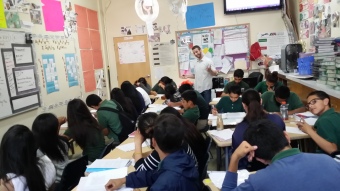
Mr. Andrew Persin (standing, center), Effective English Teacher at Academia Avance “edutaining” his 8th grade class.
Effective – describes a particular teacher who has been most successful in helping students gain knowledge and skills to be successful academically, personally, and plays a major role in forming their character. An effective teacher can be summed up in 3’E’s; educator, edutainer and an edumedic.
The Educator: reaches out to students and their families before the start of the school year to introduce themselves and gather important information about the students he is about to teach. They inspire and build positive relationships with their students on day one. The educator makes sure that on day one they have an enticing way of sharing his expectations. Key to creating an environment of learning where students feel welcome, and forming a pact with them regarding their success in class. In the classroom, I used to get all of us standing on our desk singing a modified version of the Monkee’s song, “I’m a Believer”.
The effective teacher also enjoys teaching and seeks to find the root cause of student’s misbehavior or academic performance. They work to restore relationships instead of pushing children out of class or school. It all starts with a well -planned differentiated lesson that the teacher designed himself keeping each of their students in mind. The execution of the lesson plan is delivered meticulously with the teacher not being afraid to adjust the lesson based on the data, checking for understanding, and ensuring that students are learning. The effective teacher knows how to correctively instruct in various settings; such as individually (one to one), in small groups and whole class based on observation, data and self-reflection.
The Edutainer: describes the effective teacher who educates their students while entertaining them as they participate actively in their own learning. Their classes are riddled with the “joy factor.” The effective teacher creates and presents the instructional materials in a fun and novel way that will help the students’ master and remember the materials.
The short video shows how I infused music, art, humor and fun into Math lessons as a teacher. By using this method, English Language Learners experienced and learned to conceptualize many math concepts. An effective edutainer uses whatever it takes to motivate, excite, stimulate and peek students’ interest in their lesson presentations. The eudtainer is not shy, nor afraid of organized chaos where students are learning while having fun. All forms of media that students are engaged with every day, whether video games or social media is exciting and fun, the edutainer is able to hold their attention in class and help the students to have focused fun while learning.
The Edumedic: – describes the effective teacher who identifies the needs of the student’s earlier learning experience and digs into their repertoire of tricks to rebuild and close the gap through targeted explicit corrective instruction. Each Friday, the Edumedic prepares a targeted packet for each individual student based on the data from the weeks classwork, homework and exit tickets. The goal is to provide practice and support to strengthen each student’s achievement in the areas that they were having difficulty in.
Classes can be divided into homogenous groupings during independent work time. This allows the teacher to work with each group at a pace that will enhance mastery. Struggling students can meet with their teacher before or afterschool, as this allows an opportunity to pre-teach the day’s lessons and prepare them for class later in the day. The recovery process in terms of academic gains will be enhanced because it leads to greater participation, self-confidence, and mastery of the material. The edumedic knows exactly what each student requires and provides each student with access to learning through differentiated instruction.
There are only two types of teachers, the effective teacher and the ineffective teacher. The effective teacher narrows the achievement gap because he is an educator, an edutainer and an edumedic. He believes in the potential of every student and sets out to make sure that every student learns in his class daily.
Speaking Truth to Power April 1, 2014
Posted by latinoschoolleaders in Education Policy.Tags: college and career readiness, Congress, education advocacy, George Miller, Lamar Alexander, Latino leadership, NCLB, No Child Left Behind, Tom Harkin
add a comment
By Angelica Solis, Director, Youth Policy Institute
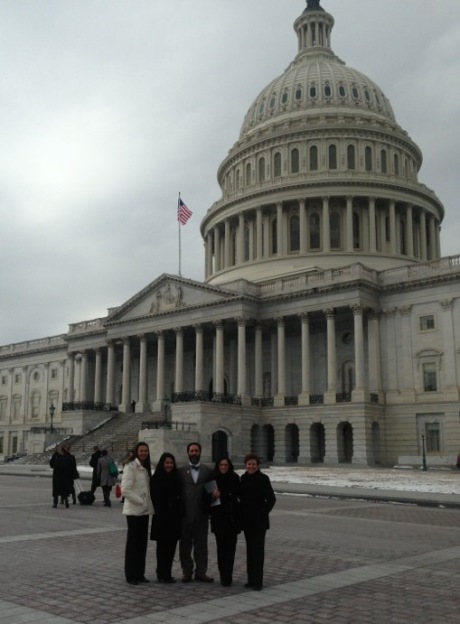 Our national leaders are charged with some heavy responsibilities: representing the community’s interest and ensuring that that representation reflects national policy. This is easier said than done. Competing community interests, disconnect between local realities and national perceptions, insufficient information about specific topic issues, and many other factors often challenge our leadership’s ability to develop policies that address the specific needs of Latino students and their families. For this reason, it is important that school and community leaders working directly with Latino communities actively engage policy makers around the issues that are vital to supporting the students and families they work with.
Our national leaders are charged with some heavy responsibilities: representing the community’s interest and ensuring that that representation reflects national policy. This is easier said than done. Competing community interests, disconnect between local realities and national perceptions, insufficient information about specific topic issues, and many other factors often challenge our leadership’s ability to develop policies that address the specific needs of Latino students and their families. For this reason, it is important that school and community leaders working directly with Latino communities actively engage policy makers around the issues that are vital to supporting the students and families they work with.
Informing and educating policy makers and their staff about important education issues such as NCLB waivers, college and career readiness standards, family engagement, and mental health, is critical to ensuring that Latino voices and experiences are not lost as our national legislators craft policies that will impact our community. Most importantly, having policy makers hear first hand the stories of how education policies play out locally, allows them to put faces to the issues and to contextualize the statistics and data that may or may not accurately capture the impacts of these policies in our communities.
On March 6, the current cohort of NCLR’s National Institute for Latino School Leaders (NILSL) had an opportunity to do just that – share their local stories, experiences and expertise around these and several other key issues impacting Latino students and families across the country. The NILSL fellows had the chance to meet with representatives from high-ranking legislative leaders such as Senator Tom Harkin (D-Iowa), Senator Lamar Alexander (R-Tenn.), Congressman George Miller (D-Calif.), and others, that are currently leading discourse and developing policies that impact our educators, schools, students and families. NILSL participants shared first-hand accounts of how their schools can use resources to support teacher development; how realignment of existing funds can impact a school’s ability to provide mental health resources to the child that has to overcome the traumas of living in a gang-infested neighborhood; and how developing clear accountability measures can ensure local schools are held accountable for erasing the achievement gap.
These were the stories the NILSL fellows carried with them as they walked the halls of Congress and met with the staff of the powerful leaders that will make decisions that impact their communities. Equipped with these stories as well as the hard facts and data related to the issue topics, the school and community leaders were unwavering in their commitment to the share the key recommendations that will ultimately lead to improved student outcomes, safe and healthy school environments, and improved community and family engagement.
Without the voices of local school and community leaders in Washington D.C., our leaders’ job of representing our Latino community interests will be difficult to fulfill, and it is in our best interest that they are successful at what they do so that our communities can be successful in return.
Preparing Our Students for 21st Century and College and Career Readiness Standards April 1, 2014
Posted by latinoschoolleaders in College Readiness.Tags: 21st Century Learning Standards, Career Readiness Skills
add a comment
By Janet Alvarez, Principal, Para Los Ninos Middle School
 I was recently asked what I think the most important aspect is to prepare our Latino students for the rigor of 21st Century Learning and College and Career Readiness Standards. As I thought about it, it isn’t the arts, literacy, science, technology, or math that we integrate into every content area. Rather, it is the inquiry and curiosity that we nurture, demonstrate and practice through our approach.
I was recently asked what I think the most important aspect is to prepare our Latino students for the rigor of 21st Century Learning and College and Career Readiness Standards. As I thought about it, it isn’t the arts, literacy, science, technology, or math that we integrate into every content area. Rather, it is the inquiry and curiosity that we nurture, demonstrate and practice through our approach.
Our students are curious about the world around them, hungry for more information about why things work the way they do and how to make them work even better. This curiosity is what ignites a thirst for learning in our students and energizes them to be innovative thinkers.
Typically, 21st Century and College and Career Readiness Skills, are referred to as; critical thinking, communication, creativity and collaboration. These skills are extremely important, and the structure and tools to practice them in school are crucial.
I would like to add two more “C’s” to that list: curiosity and confidence.
Curiosity is a student’s fundamental motivation for learning. Without it, students would never wonder, never question, and never try again after failing. Our students need to see curiosity in action through demonstration. They need the time, structure, and devices to guide their curiosity into inquiry, exploration and learning. They also need meaningful ways to reveal their innovations, challenges and thoughts along the way.
Building confidence in our students is one of the most powerful “C’s” of all. Acknowledging student accomplishments privately, and in front of a group boosts their belief in their capabilities. Further, allowing students the opportunity to self-select their own activities will help them build their self-worth.
Encourage students, when they are performing a task or getting involved in an activity, to do better than they did before, NOT better than someone else! And finally, express a positive attitude toward our students so they see that they are worth your time and attention.
How about you? How are you encouraging 21st Century skills for our students?
Creating a Climate of Possibility for Latino Youth February 19, 2014
Posted by latinoschoolleaders in Common Standards, Principal Effectiveness.Tags: climate of possibility, Common Core State Standards, English learners, Glendale Middle School, Sir Ken Robinson, TED Talk
add a comment
By Jennifer Mayer-Glenn, Assistant Principal, Glendale Middle School, NILSL Fellow, NCLR
I recently watched Sir Ken Robinson’s TED Talk on school leadership for the fourth time. Each time I understand more deeply and clearly the role of a school leader. Robinson says the “real role of leadership” is to create a climate of possibility. As I reflect on student populations like the one at the school where I am a leader, there has not been a climate of possibility for most students for many years. Our diverse population of refugees, children of refugees, new immigrants, children of new immigrants, English learners, and generations of under-served students need us to create that climate of possibility.
Our students need schools that provide an education that is individualized and personalized. At Glendale Middle School in Salt Lake City we work to create varied personalized programs or projects that “hook” our students to their learning so that they can see the purpose and possibility. What is more culturally relevant for a student than working on a project to improve one’s own community or making a movie about a current issue at school?
School leaders must also create a climate of possibility for their teachers. Students have been conditioned into believing that they cannot achieve at high academic levels, as have many teachers. They too believe that their students are not able to achieve at high academic levels. If teachers and students alike do not believe it is possible, then it is not possible. Our job is to create a system to support teachers to know what is possible and to develop the heart, the will and the skill to make the change necessary for our Latino students and English learners to achieve at high levels.
In addition to creating a climate of possibility is the necessity to create a well run system that insists on high quality instruction and assessment, and the use of data to drive instruction, intervention and professional development. The Common Core State Standards are a rigorous tool to focus teachers and students on high expectations. Forbes Magazine’s list of The Eight Characteristics of Effective School Leaders mirrors what is possible and what our students need: high expectations, relentlessness, personal development of every student, rich opportunity within and out of the classroom, partnerships with parents and the community, and rigorous data analysis.
As we continue the work to create climates of possibilities for our students and teachers we may find ourselves achieving things we never would have expected.
Go Slow to Go Fast February 19, 2014
Posted by latinoschoolleaders in Principal Effectiveness.Tags: attendance, classroom procedure, English learners, teacher effectiveness
add a comment
By Kevin Myers, NILSL Fellow, NCLR
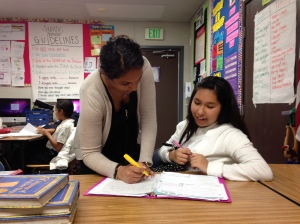 Students walk into a classroom with an innate trust in teachers. They trust teachers to educate, to support academically and emotionally, and they trust teachers to guide them through a year of overall development. With all of the different facets of teaching and the pressure of testing accountability bearing down on them, balancing the needs of all students is a difficult undertaking. To be effective, teachers need to juggle many different tasks, countless student needs, and hundreds of varying resources.
Students walk into a classroom with an innate trust in teachers. They trust teachers to educate, to support academically and emotionally, and they trust teachers to guide them through a year of overall development. With all of the different facets of teaching and the pressure of testing accountability bearing down on them, balancing the needs of all students is a difficult undertaking. To be effective, teachers need to juggle many different tasks, countless student needs, and hundreds of varying resources.
When working with populations of students with a high percentage of English learners, maintaining focus and balancing all of these plates at once is even more important. It’s easy to get lost in the myriad of “To Dos” that pop onto a teachers task list, but I believe there are important strategies that teachers need to use on a daily basis to ensure that they are effective with their English learners and with all of their students. In order to maintain that innate trust students have in educators, we must initiate frequent checks for understanding, provide meaningful and immediate feedback, and build relationships with kids.
As the kids pile through the classroom door, a million different cues and must-dos run through a teacher’s head. Attendance, Do Nows, passing back work, classroom procedures, correcting behavior, and starting a lesson are all thoughts zooming around in a teacher’s mind, colliding with each other and creating a lot of internal chaos. When this happens to me, I like to think back to something I heard during an Inquiry by Design professional development session. The trainer said to the class, “You need to go slow so you can go fast.” This seems like a paradox at first, but in actuality, it’s wonderful advice! When all of the tasks and stresses of teaching start to collide, it’s imperative for teachers to take a breath and slow down. One strategy for slowing down is to plan frequent checks for understanding into a lesson.
 Kids need for teachers to focus on the lesson and what is currently being taught, not what else still needs to be done during that period. When teachers use strategies like Think-Pair-Share, Thumbs-Up/Thumbs-Down, or evaluating an idea by showing a number of fingers (1-4 seems to be effective), kids have time to process what is being taught during the lesson. By intentionally taking the time to pause and check in with students, teachers are ensuring that kids are ready to move on to the next step. When the kids are ready to move on, teachers won’t have to spend stressful minutes going back and re-teaching. If teachers take time to make sure kids are with them through checks for understanding, they will definitely be more effective with all students, including our English learners.
Kids need for teachers to focus on the lesson and what is currently being taught, not what else still needs to be done during that period. When teachers use strategies like Think-Pair-Share, Thumbs-Up/Thumbs-Down, or evaluating an idea by showing a number of fingers (1-4 seems to be effective), kids have time to process what is being taught during the lesson. By intentionally taking the time to pause and check in with students, teachers are ensuring that kids are ready to move on to the next step. When the kids are ready to move on, teachers won’t have to spend stressful minutes going back and re-teaching. If teachers take time to make sure kids are with them through checks for understanding, they will definitely be more effective with all students, including our English learners.
With a million things on our minds, it would be easy for an educator to get bogged down in the stress and the obligation of everyday work. But if we peel back the curtain to get a glimpse of the reason we all got into this field, we will see the students. We all want to be effective educators so our kids can be successful, and if we take the time to go slow- to check for understanding, to provide feedback, and to build relationships- we will be effective indeed.

